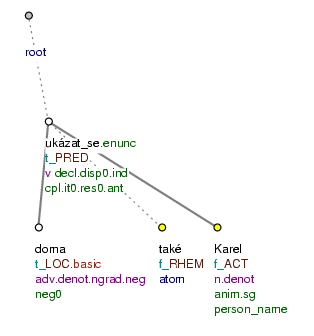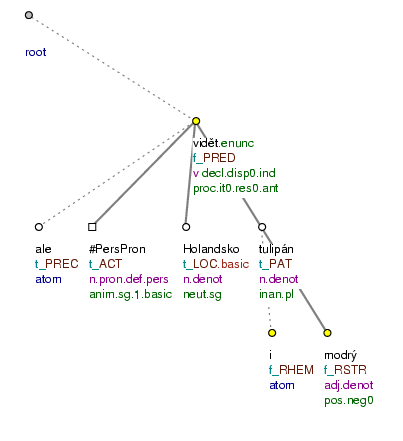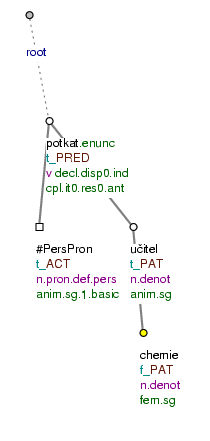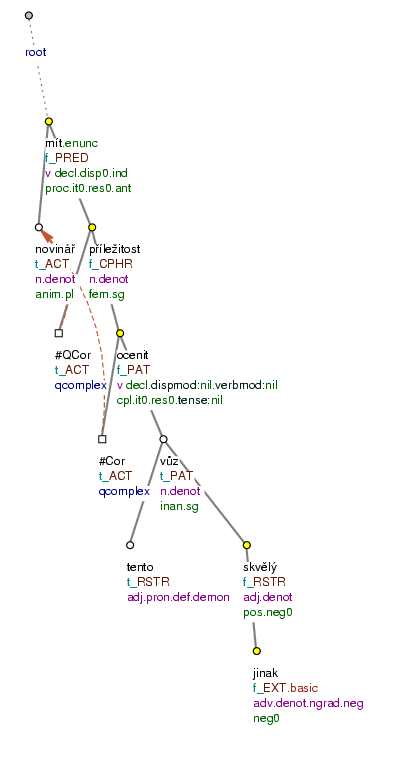There are three basic guidelines for the ordering of nodes in a tectogrammatical tree:
-
the most general guideline of the underlying word order is the placing of nodes representing contextually bound expressions (nodes with the values
torcin the attributetfa) to the left from their governing node and the placing of nodes representing contextually non-bound expressions (nodes with the valuefin the attributetfa) to the right from their governing node.Exceptions. There are a few exceptions to this rule:
-
a node representing a quasi-focus (see Section 3.1.2, "Quasi-focus"), although it is contextually bound, depends to the right from its governing node.
-
a node representing a rhematizer whose scope contains its governing verb which is contextually non-bound has the
tfavaluef, but is placed to the left from the node representing the verb (see also Section 6.2, "Basic guidelines regarding the position of rhematizers in tectogrammatical trees"). -
the effective root of a syntactically non-incorporated parenthesis (a node with the functor
PAR) has usually thetfavaluef, but it stays in the tectogrammatical tree at the same place as in the surface word order, i.e. even though it is to the left from its governing node (see also Section 4.2, "Topic-focus articulation and the semantic type of dependency relation (functor)"). -
nodes representing predicates of certain types of subordinate clauses (mostly causal) can have the
tfavaluefand at the same time be to the left from the governing predicate node (see also Section 4.3.3, "Topic-focus articulation of dependent verbal clauses"). -
in the case of ellipsis of the governing noun in paratactic connections of sentence parts (of the type "červené a bílé víno (=red and white wine)"; see Section 12.1.2.1, "Textual ellipsis of the governing noun"), the second (expressed) noun has the
tfavaluet, but it still depends to the right from the paratactic structure root even though thetfavalue of the first member of the paratactic structure isf(see Section 2.2.4, "Contextual boundness of expressions absent in the surface structure of the sentence").
-
-
in the underlying word order, the focus proper (see Section 3.1.1, "Focus proper") is placed on the rightmost path leading from the effective root of the tectogrammatical tree, even though it is at a different position at the surface structure. If the focus proper is constituted by an expression represented as the effective root of the tectogrammatical tree (i.e. the governing predicate is the focus proper), there is no right path from the effective root. For more information see Section 3.1.1, "Focus proper".
-
the tectogrammatical tree is projective (see Section 3.4, "Projectivity of tectogrammatical trees").
Compare:
-
Černý [
tfa=f] kocour [tfa=t] se napil [tfa=f] ze své [tfa=t] misky [tfa=f] (=lit. (The) black tomcat _ drank from its bowl.)Depending on their contextual boundness (the
tfavalue), nodes are placed either to the left or right from their governing node, not necessarily from the effective clause root (governing verb). Cf. Fig. 10.4. -
Prezident [
tfa=f] Klaus [tfa=t] odjel [tfa=f] včera [tfa=t] na zahraniční [tfa=f] návštěvu [tfa=f] (=lit. President Klaus left yesterday for (an) international visit.)Verb in the second position in the sentence (see Section 1.1, "Surface word order"). Cf. Fig. 10.5.
-
Taky [
tfa=f] KAREL [tfa=f] se doma [tfa=t] ukázal [tfa=t] (=lit. Also Charles _ at_home showed_up.)Subjective order (see Section 1.1, "Surface word order"). In the tectogrammatical tree, all nodes are at their unmarked positions according to the basic guidelines for the ordering of nodes in a tectogrammatical tree: nodes are placed either to the left, or to the right from their governing node (according to their
tfavalue). Cf. Fig. 10.6.
Figure 10.4. Ordering of nodes in a tectogrammatical tree
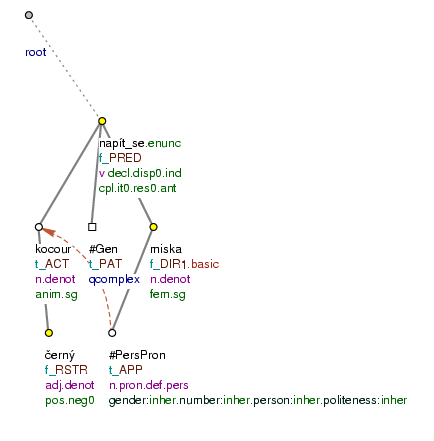
Černý kocour se napil ze své misky. (=lit. (The) black tomcat _ drank from its bowl.)
Figure 10.5. Verb in the second position in the sentence
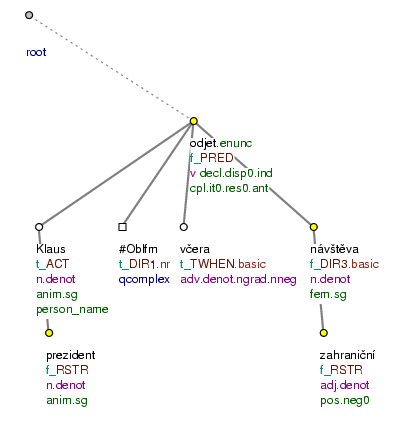
Prezident Klaus odjel včera na zahraniční návštěvu. (=lit. President Klaus left yesterday for (an) international visit.)
Focus proper is the most dynamic and communicatively significant contextually non-bound part of the sentence.
In the spoken form of a sentence, focus proper carries the intonation centre (see Section 1.2.1, "Intonation centre").
If a nominal group (noun phrase) is the focus proper, the intonation centre is usually placed at the last word of the nominal group, even though it is not its most dynamic member. This is caused by the highly grammaticalized word order in nominal groups (see also Section 3.3, "Ordering of nodes in nominal groups (noun phrases)").
Focus proper (see Section 3.1.1, "Focus proper") is placed on the rightmost path leading from the effective root of the tectogrammatical tree, even though it is at a different position at the surface structure. If the focus proper is constituted by an expression represented as the effective root of the tectogrammatical tree (i.e. the governing predicate is the focus proper), there is no right path leading from the effective root.
NB! On the rightmost path from the effective root of the tectogrammatical tree, there can be even contextually bound nodes (so-called quasi-focus - see Section 3.1.2, "Quasi-focus").
Compare:
-
(Mám rád červené tulipány, ale) v Holandsku jsem viděl i tulipány [
tfa=t] modré [tfa=f] (=lit. ((I) _ like red tulips, but) in Holland (I) have seen even tulips blue.)The focus proper consists of the contextually non-bound expression modré (=blue). The node representing this expression will be placed rightmost in the tectogrammatical tree (it will be a leaf on the rightmost path in the tectogrammatical tree), in spite of the fact that the governing node of the focus proper is the contextually bound expression (quasi-focus) tulipány (=tulips) . Cf. Fig. 10.7.
Quasi-focus is constituted by (both contrastive and non-contrastive) contextually bound expressions, on which the focus proper is dependent (see Section 3.1.1, "Focus proper"). The focus proper can immediately depend on the quasi-focus, or it can be a more deeply embedded expression.
In the underlying word order, nodes representing the quasi-focus, although they are contextually bound, are placed to the right from their governing node. Nodes representing the quasi-focus are therefore contextually bound nodes on the rightmost path in the tectogrammatical tree.
Compare:
-
(Kterého učitele jsi potkal?) Potkal jsem učitele [
tfa=t] chemie [tfa=f] (=lit. (Which teacher did (you) meet?) (I) met _ (the) teacher of_chemistry.)The contextually bound expression učitel (=teacher) is the quasi-focus (the focus proper, the expression chemie (=of_chemistry), is dependent on it). In the tectogrammatical tree, the node representing the quasi-focus will be placed to the right from the governing node representing the predicate potkat (=to_meet) . Cf. Fig. 10.8.
-
Novináři měli příležitost ocenit tento jinak skvělý [
tfa=f] vůz [tfa=t] (=lit. Journalists had (the) opportunity to_appreciate this otherwise superb car.)The contextually bound expression vůz (=car) is the quasi-focus (the focus proper, the expression skvělý (=superb) , is dependent on it). In the tectogrammatical tree, the node representing the quasi-focus will be placed to the right from the governing node representing the predicate ocenit (=to_appreciate) . Cf. Fig. 10.9.
